In a previous post (Getting you Containers Spring Flowers Ready) plants that can be used to give a colourful display in spring was discussed. Time is now moving on and now we must turn our attention to making our summer displays in container look beautiful.
In this article, we will be getting our containers summer flower ready. It is important to realise that whilst relaxing on the patio or backyard you will observe your containers more. This would mean the plants within them must look good, be of peak condition and be colourful all season long, or you will feel disappointed.
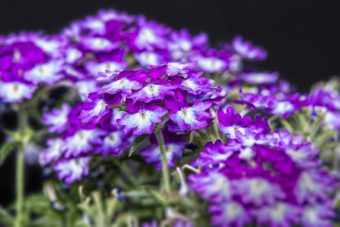
Annual beddings such as impatiens, petunias, verbena and nemesia will provide colour through the summer months.
Maintenance is also of the upmost importance, as so many displays disappoint because of poor watering or feeding regimes. Summer containers need regular watering and deadheading to produce their colourful displays.
It is advised to use some leafy specimens such as hebes and hostas, mixed in with flowers to give some green contrast to the container displays. How to look after planters and containers has been described here.
What follows are the beautiful flower that can be used to give a stunning container display:
ABUTILON ‘Nabob’

This large evergreen shrub growing up to 3m has maple-like leaves, and in summer bowl-shaped crimson flowers are produced. Grow this shrub in a large container full of soil-based compost, using a cane framework to support its delicate branches. Not fully hardy, so will need frost protection in winter.
AGERATUM HOUSTONIANUM (Floss Flower)
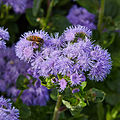
This is a small, compact annual, growing up to 30cm in height. During the summer months fluffy pink, white or blue flowers are produced in large quantities. The leaves are small and coarse and are dark green in colour. Plant in pots, hanging baskets and window boxes full of multipurpose compost. Remember to water and deadhead regular.
ANTHEMIS PUNCTATA SUBSPECIES CUPANIANA (Sicilian Chamomile)

This spreading evergreen perennial produces masses of daisy-like flowers with white petals and yellow centres. The leaves are small and silvery in nature. Grow in soil-based compost with other bedding plants in full sun. It will grow up to 30cm in height.
ANTIRRHINUM MAJUS (Snapdragon) ‘Luminaire Series’

This is a trailing variety of the familiar snapdragon, where it will look the best hanging over the sides of hanging baskets or other containers. It will grow up to 0.5m in length, where short spikes of lightly-scented flowers of multiple colours are produced. Plant in multipurpose compost and protect from strong winds.
BIDENS FERULIFOLIA

This perennial often treated as an annual, only grows 30cm high, but can trail indefinitely. The ferny like leaves are covered with yellow flowers on top of the leaves. They are ideal as an edging plant in tall pots or hanging baskets. They look stunning when planted in multipurpose compost in full sun with germaniums and dwarf zinnias.
BRACHYSCOME IBERIDIFOLIA (Swan River Daisy)

This bushy annual has feathery, green leaves from which blue, pink, purple or white daisy-like flowers appear all some. Looks decorative in window boxes, pots or hanging baskets when planted in multipurpose compost in full sun. It will grow up to 25cm in height.
CALIBRACHOA ‘Million Bells Series’

Another perennial that is often grown as an annual, where pink, yellow, red, blue or white trumpet-like blooms are produced all summer. The leaves are elongated oval in shape but pale into insignificance compared to the flowers. Grows up to 30cm in height when planted in multipurpose compost in full sun. Ideal for decorating containers.
CLEMATIS ‘Shimmer’
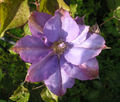
This deciduous climber really does send a shimmer down your spine, as it is a real beauty. It is a compact variety of clematis, only growing up to 1.8m in height, where large, deep lilac flowers appear over the oval, green leaves throughout the summer months.
Plant in a large pot of multipurpose compost with a trellis support.
CONVOLVULUS SABATIUS (Blue Rock Bindweed)

This short perennial, sold as an annual summer bedding, has a trailing habit, where small leaves are studded with funnel-shaped, blue-purple flowers. Use in window boxes, hanging baskets or pots filled with multipurpose compost, as an edging plant. In full sun it is expected to grow to 20cm in height.
COSMOS BIPINNATUS

This familiar annual tends to be found in a lot of gardens. This plant, which can grow up to 1.2m tall, produces large daisy-like pink, red, or white blooms. The green leaves are feathery in nature. Plant in multipurpose compost in full sun.
CUPHEA IGNEA (Cigar Flower)

This medium-sized annual of lance-shaped leaves produces small, tubular, scarlet flowers with black tips (the cigars). It makes a decorative feature in pots and window boxes full of multipurpose compost in full sun. Plant it with fuchsias or pelargoniums. , where it will grow up to 75cm in height.
DAHLIA ‘Gallery Art Deco’
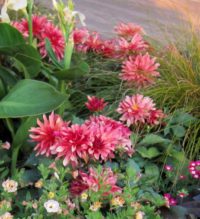
This dahlia has double blooms of burgundy edged pale orange petals over lobed green leaves. It offers colour in pots from midsummer to autumn. Prefers to be grown in multipurpose compost in full sun. Will need frost protection so do not plant the tubers too early. The plant will grow up to 45cm in height.
DIASCIA BARBERAE

A mat-forming perennial that is often grown as an annual bedding plant, where it will grow up to 25cm in height. In summer to autumn wiry stems of apricot pink blooms are produced on small pointed green leaves. It can be used as a trailing plant in pots or hanging baskets of multipurpose compost in full sun. This is one plant that will reward you well if you feed, water and deadhead regular.
FUCHSIA
No summer container garden will be complete without the use of Fuchsia. They all prefer to be grown in a soil-based compost in full sun or partial shade, where they can grow up to 75cm in height.

Fuchsia ‘Thalia’ an unusual fuchsia in that it produces masses of tubular red flowers from summer to autumn. It produces dark green leaves which are maroon underneath (that is what makes it unusual). It makes an excellent centrepiece in a mixed summer bedding display.
Fuchsia ‘Tom Thumb’ is a dwarf variety and is suitable for growing in window boxes and hanging baskets. In summer bell-shaped, pink-red and mauve flowers are produced, over oval green leaves. Best combined with lobelias and petunias.
Fuchsia ‘Firecracker’ is a bushy variety of fuchsia that has green and cream variegated leaves that have pink undersides. In summer and autumn long, slender, tubular, coral coloured flowers are produced. It grows up to 75cm in height.
GAZANIA (Treasure Flower) ‘Talent Series’
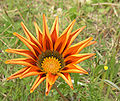
This annual will provide a colourful addition to pots, hanging baskets and window boxes. It produces daisy-like, yellow-orange, pink or maroon flowers over small oval green leaves. It grows up to 22cm in height when planted with other annuals in multipurpose compost in full sun.
GERBERA (Florist Gerbera) ‘Mount Rushmore’

This decorative perennial (grow up to 40cm in height) has lobed green leaves from which tall stems of daisy-like, yellow, pink or orange flowers with black centres are produced. Grow them in pots full of multipurpose compost in full sun and away from frosts.
HELIANTHUS ANNUUS (Sunflower)

Everybody is familiar with sunflowers with their large yellow flower heads with large dark centres, along with large green leaves. The annual will need to be supported and so a bamboo cane is recommended to undertake this task. Generally, the giant varieties are not suitable for container growing, but the dwarf varieties are, such as ‘Teddy Bear’.
They can grow up to 90cm in height but do not forget to support to prevent wind damage. They prefer to grow in multipurpose compost in full sun. You can pinch out the stem tip to produce several smaller heads or you can leave alone to form a larger, single bloom.
IMPATIENS (Busy Lizzie) ‘New Guinea Group’

This short-lived perennial produces a vast number of pink, red, white flowers over green oval leaves throughout the summer months. It can be used as a sole specimen or mixed with other annuals in pots or multipurpose compost in partial shade. It will grow up to 30cm in height.
ISOTOMA AXILLARIS (Star Flower)

This interesting perennial, often grown as an annual, with its feathery green foliage from which lilac or blue star-shaped flowers emerges. Star flower can be grown singly or mixed with fuchsia and dahlias in large pots of multipurpose compost in full sun. Will grow up to 30cm in height in ideal growing conditions. Look out for ‘Avant Grande’.
LAVANDULA (French Lavender) ‘Willow Vale’

Grow this classic shrub as a sole specimen in a large container filled with a sandy multipurpose compost in full sun. The foliage is grey-green and the blooms are deep purple and topped with wavy, reddish-purple flower tracts. It flowers from early to midsummer where it will grow up to 75cm in height. An alternative includes lavender ‘Fathead’
LOBELIA ERINUS (Trailing Lobelia)

This trailing annual has stems of finely divided dark green leaves and tiny blue-purple flowers. The flowers appear from summer to autumn, provided the container that they are planted in is moist at all times. The 20cm tall plant can be grown in pots, window boxes, or hanging baskets full of multipurpose compost in full sun.
NEMESIA ‘KLM’

Another perennial, commonly grown as an annual, has a spreading habit. The mat of green leaves and wiry stems of small, scented blue and white flowers are produced all summer. Grow this 30cm tall plant in pots, window boxes and hanging baskets in multipurpose compost in full sun. Many other varieties of nemesis can be used, covering a wide range of colours, so buy those that tickle your fancy.
NICOTIANA (Flowering Tobacco) ‘Domino Series’

This upright annual has large, oval green leaves and lightly scented summer flowers that come in shades of purple, pink, red or white. This 45cm tall perennial combines well with trailing lobelias and Swan River Daisies in multipurpose compost in partial shade.
OSTEOSPERMUM (African Daisy)

The African daisy is another perennial that is often seen in summer displays in gardens everywhere. These plants are evergreen perennials with grey-green leaves and long-lasting flowers. They prefer to be grown in soil-based compost in full sun. To preserve the plant, move it to a sheltered site in winter.
Osteospermum jucundum has daisy-like pink blooms, which grows up to 30cm in height.
Osteospermum ‘Serena’ has pale pink daisy-like flowers, which grows up to 30cm in height.
Osteospermum ‘Sunny Series’ has daisy-like flowers of pink or mauve hue, where it grows up to 35cm in height.
PELARGONIUM ‘Lord Bute’

An evergreen perennial, often grown as an annual, has deep purple-red blooms, set against rounded hairy leaves. They flower throughout the summer months and can be grown in pots and window boxes. There are many pelargonium varieties that can be grown and all of them are suitable to be grown in a container, so the choice is up to you. They grow up to 45cm in height when planted in multipurpose compost in full sun.
PETUNIA ‘Phantom’

This eye-catching bedding plant produces a multitude of trumpet-shaped flowers that are almost black, with a gold central star. It grows up to 30cm in height in multipurpose compost in full sun. Combines well with Rudbeckias. The ‘Thumbelina Series’ also does well in containers.
RHODOCHITON ASTROSANGUINEUS (Purple Bell Vine)

In containers, people often forget to add height, as this will give an extra dimension to any summer container garden.
The climber has heart-shaped leaves and from the stems, pink-red ‘hats’ with maroon tubes are produced throughout summer. Plant in a large container of multipurpose compost in full sun, where it will grow up to 3m in height, This climber will need to be supported.
RUDBECKIA HIRTA
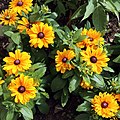
Yet another perennial that is often grown as annuals, had large, daisy-like yellow flowers with dark brown centres. They grow up to 90cm in height multipurpose compost where if kept well-watered, they will flower from summer to autumn. Grow in full sun, where many varieties can be grown.
SALVIA SPLENDENS ‘Cleopatra Series’

This short annual bears upright spike of red or purple flowers, where they will give a vibrant addition to any container. Plant them in pots of multipurpose compost in full sun, where they will grow up to 30cm in height.
SUTERA CORDATA

A trailing perennial, often grown as an annual, can be used to grow over the sides of pots, hanging baskets and window boxes. It only grows up to 10cm in height but will trail indefinitely. The plant forms a curtain of small, white or pale pink flowers over green leaves. Grow in multipurpose compost in full sun. Feed and water regularly.
THUNBERGIA ALATA (Black-Eyed Susan)

This climber can be grown in large pots in full sun, using a wigwam of support canes. The plant will grow up to 3m in height where the stems are clothed with heart-shaped leaves and bright orange or yellow flowers with really dark centres are produced. Water and feed well in order to produce more blooms. Multipurpose compost is their preferred growing media.
VERBENA ‘Novalis Series’

This 25cm tall annual is a popular container plant that is grown for its grey-green leaves and rounded red, pink, orange, purple or white flower heads that appear all summer long. Grow in containers full of multipurpose compost in full sun. Fills gaps between larger flowers in containers in pots.
Other possibilities include Verbena ‘Aztec Red’ or Verbena ‘Diamond Merci’.
ZINNIA ‘Thumbelina Series’

This dwarf annual has dark green leaves from which semi-double flowers in shade of red, yellow, maroon, or pink appear. Grow in pots, window boxes or hanging baskets in multipurpose compost in full sun, where it will grow up to 15cm in height.
CONCLUSIONS
In this article, plants for summer container flowers have been discussed. There are a large variety of annuals, perennials, shrubs and climbers that can be used.
If you use the plants suggested in this article you will have hanging baskets, window boxes and pots full of colours covering all the spectrum, they will all vary in height and have different forms, but all plants will be a point of interest, so get creative.
If you have a comment that you wish to make or a question that you wish to raise, please do so by leaving a comment in the box below.
Happy summer gardening.

Thanks for sharing such an informative article with us. Through your article I got the idea that what are the summer ready flowers that we can display. You not only discussed about the colourful summer beddings but also the way to maintain and taking care of the flower. Summer containers need regular watering, large variety of annuals, shrubs, climbers that can be used are discussed. I would like to share your article with my friends and family so that they will gain knowledge about it.
Hi nahifabinthe
Thank you very much for your reply, as I try to be as helpful as possible with my suggestions that anybody can have a beautiful container display. All is required is a little time and effort.
Kind regards
Antonio
Hello Antonio. I love your choice of summer flowers. They are all so colourful. I recognized many of them but I think my favourites are the Bidens Ferulifolia (I love yellow flowers), the Clematis, and Impatiens. I don’t get to plant flowers anymore because my husband and I travel and house sit but we do have the opportunity to enjoy the beautiful gardens of others.
Hi Mary Ann
Thank you for stopping by and commenting. To many gardeners summer is the best time of year with all the colour can be readily seen. You have so many choices and you can experiment. It is a shame that you cannot make your own but you never know you may get the bug again.
Thanks
Antonio
Wow, this is really a great article. It is also very detailed. We love flowers, even our house is surrounded by beautiful garden with different flowers. I totally agree that summer flowers require regular watering to produce colorful display. I like the list of flowers you have provided in this article but I am more pleased with Dahlia ‘Gallery Art Deco’, looks very impressive. Thank you very much
Baraka
Hi Baraka
I could not agree much more with what you have said, as often summer contain displays look rubbish if they are not looked after well, either by not feeding or watering or by not deadheading.
Dahlias are such wonderful plants.
Thanks
Antonio
Even though I am a hydroponic grower – I do love looking out over my patio or front porch and seeing flowers. The summers can be very hard on flowers in our area. Looking for something that could manage and will stay colorful yar round. I have tried to buy these bags of wildflower seeds without much luck. Even tried Sunflowers before (that’s of course if the birds don’t get to the seeds first.) Hadn’t realized that there were dwarf varieties. The height seems right and the ability to weather full sun is a big plus. How tall should I expect the Rudbeckia Hirta to grow? We know them here as Blacked Eyed Susan. Not sure if we will need a dwarf version if they grow too tall. A great post will bookmark it for future reference.
Hi Steve
I can understand the beauty of hydroponic growing but I personally like getting my hands into the soil. You can try any of these plants and they should do well. Dwarf sunflowers are great as you can see the beautiful flowers at very close range, which cannot be done if you grow a giant . Rudbeckia hirta can grow anywhere from 20cm for dwarves to 90cm for giants, so you do have a choice. Here in the UK we call them cone flowers, but they are all little yellow balls of sunshine. Hope you catch the bug.
Thanks
Antonio
You provide a wide array of flower plants to choose from. I appreciate how you help your reader know the best ways to care for their plants.
Our garden is drought resistant since we live in a zone where the rainfall is low. In our case, we would need to use flower pots to plant and grow these flowers and water them manually. It looks like it could be worth the effort of add color to our drought resistant garden. My favorites are fuchsias, snapdragons and dahlias.
Thanks for providing some great ideas to make our garden colorful for an extended period of time.
All the best to you.
Edwin
Hi Edwin
As ever thank you very much for stopping by once more and commenting. I always try to give my readers as much choice as possible but I do have an article that will be of interest to you Drought-Tolerant Perennials for Containers in the Shade and Plants for Sunny and Dry Conditions- Growing Drought Tolerant Plants in Full Sun. You will get a lot from them.
Thanks
Antonio
First of all, thank you so much for sharing such a beautiful and informative article.
I am a flower lover. In my house, I have a flower garden. There are some different flowers. After reading this article I knew about some new flower plant before I didn’t know it about this. I hope I will collect all this flower tree. Every flower lover will get benefit after reading this article.
Thanks again for sharing this informative post. I will share the post with others. 😊
Hi Shamiimbd
Thank you very much for your comment, as I try to make the world a much better place by introducing colour and beauty. So why do you not try some of these plants in your container garden this summer.
Thanks
Antonio
First of all, I would like to give you thanks and respect for your extraordinary article. This article can change our atmosphere because you’ve said about the container plants and gardening which is the most effectual for our society. I remember, when I saw your article; I felt very happy. Instantly, I started plantation and gardening. It makes me happy. I inspired by your article and bought some container to plant some flower tree. After that I planted sunflower, Florist Gerbera, star flower and so on.
I thankful to you for publish this kind of article. Obviously, I will share this article with my friends and my relative so that they can get some knowledge about gardening. Should I share your article on my social media?
Hi magadihassan
Thank you for your detailed reply as I very much appreciate it. When you are gardening you try to bring as much beauty into a space where you spend so much time in, especially what is happening now. I think colour is so important.
Kind regards
Antonio
Thank you for allowing me the opportunity to comment on Container Plants and Gardening Growing plants in containers. I think that the use of some leafy specimens such as hebes and hostas, mixed in with flowers to give some green contrast to the container displays is excellent advice. This will also cause the other colors to become more rich and stand out more.
I really like how you have listed the different types of flowers and their descriptive environmental growth.
Thank you for providing this information and creating this post.
I love it! the post, tip and advice… really helpful! Thank you!
Have a Blessed day!
Hi Jerry
I believe it is important to give all the relevant information when listing plants, as obviously you what to know how to grow them and how to get the best for them. In summer, you can have a vast array of colours at your finger tips and hence why this article was written.
Kind regards
Antonio